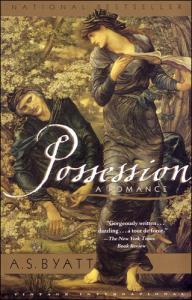 I am enjoying the multiple layers of A. S. Byatt's ventriloquism act in Possession. As author not only of a contemporary romance between two scholars, but also of a 19th century epistolary one between the two poets studied by those writers, Byatt then gives herself the additional burden (or fun) of having one of those poets write about a third poet - Samuel Taylor Coleridge. That would be a writer writing about a writer, writing about a writer.
I am enjoying the multiple layers of A. S. Byatt's ventriloquism act in Possession. As author not only of a contemporary romance between two scholars, but also of a 19th century epistolary one between the two poets studied by those writers, Byatt then gives herself the additional burden (or fun) of having one of those poets write about a third poet - Samuel Taylor Coleridge. That would be a writer writing about a writer, writing about a writer.I have not had occasion to tell you - though I tell all I meet, with the regularity with which dear Crabb tells his tale of retrieving Wieland's bust - I once met Coleridge, I was once taken to Highgate - when I was very young and green - and had the chance of hearing the Angelic - (and mildly self-important) voice speak on and on - of the existence of angels and the longevity of yew-trees, and the suspension of Life in Winter (the banal and truly profound thick and fast upon each other here) and premonitions of the Duties of Man (not Rights) and how Napoleon's Spies had been hot on his heels in Italy on his return from Malta - and on True Dreams and Lying Dreams. And more, I think. Nothing on Christabel.I might describe this book as a layered confection of the imagination. It is more like eating sweet than savory (at least at the moment). This extended section of letters might be a bit of marzipan. Delicious but densely sweet and I find myself not wanting to gorge too much of it in one sitting. Imagination is also a subject of this novel, as the two poets correspond about their creative inspirations, frustrations, and habits.
I was so young and green, I worried inordinately that I had no chance, in all this spate of brilliant monologue, to interpose my own voice - to be heard to be able to think in that company - to be remarked. I do not know what I should have said if I could have spoken. Very likely something futile or silly - some erudite and pointless questioning of his doctrine of the Trinity, or some crude wish to be told the end of the poem Christabel.
What will you be thinking of me now? I told you - I cannot think of anything without imagining it, without giving it shape in my mind's eye and ear. So, as I said, I have the clearest mental vision of yr unseen Porch, overarched with Clematis - one of those delightful deep-blue violet ones - and little clambering roses. I have also the clearest vision of your parlour - with its two peaceful Human inhabitants employed - I will not say at netting, but perhaps at reading - aloud, some work of Shakespeare or Sir Thomas Malory - and Monsignor Dorato all lemony plumes in a filgree dome - and your little dog - now of what kind is he?What a delightful game, both for the 19th century poet who employs it as a sort of flirtation and for Byatt, the 20th century writer, imagining what he would imagine. I recognize this skill instantly as the sign of the kind of artist I respect - a well-exercised and fertile imagination is not sufficient to artistry, one needs craft too, but it is necessary, as without it one would have nothing to exercise one's craft for. If you're a creative process lunatic like me, then you are constantly looking for clues about that process in every work by an artist and any biography of them. And if said artist has written letters, diaries, or - on rare occasion - a book on their creative journey, then what a treasure I have found (see list below)! As I read the letters between these two fictional writers, I find myself wondering how much of Byatt's own process is in each of them.
My Life in Art by Konstantin Stanislavski
The Creative Habit by Twyla Tharp
Growing Pains - The Autobiography of Emily Carr
Chaliapin - by Victor Borovsky
The World According to Mike Leigh by Michael Coveney
















No comments:
Post a Comment